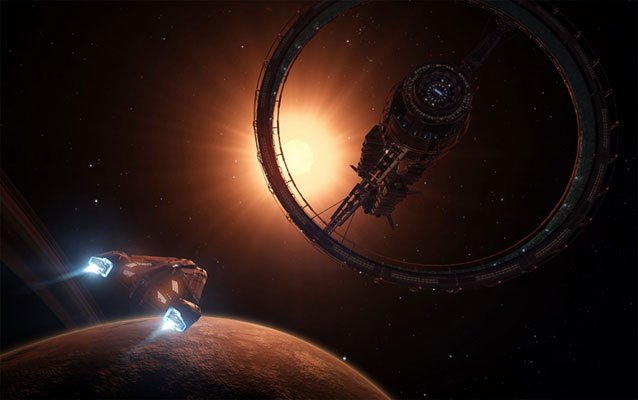


Space is incomprehensibly vast. In our galaxy alone there are an estimated 200 to 400 billion stars. And despite the fact that only a small faction of them are visible to the naked eye, it's hard not to look inward as we look upward at that great expanse. It makes us realize just how small we truly are.
I think that's why I love space games so much, specifically those that put us in direct control of a ship. They allow us the fantasy of exploration beyond humanity's limited dimensions and to travel to distant worlds we can only imagine with our heads tilted back in the dark. Sadly, we've seen a drought since the era of Wing Commander, Tie Fighter and Freelancer, but thanks to crowd funding and independent developers the genre is making a rather strong return. One of the more recent examples to reach players' hands is the beta of Frontier Developments' Elite: Dangerous, the third sequel to 1984's very popular Elite.
Developed by one of Elite's original minds, David Braben, Elite: Dangerous is an open-ended space adventure and simulation. There's no story to follow save for those you create yourself as a trader, courier, explorer, mercenary or even pirate in a Milky Way galaxy eventually to scale with our own. Additionally, all of that takes place in a multiplayer, online environment (though you can choose to play in a solo instance). It's set to be a fairly massive game, as one would hope to the legacy of the highly influential Elite series, and they're promising it will only get bigger in time with future expansions.

My own story began, as it does for most, just outside the Azeban City station situated in the Eranin system. Everyone starts with 1,000 credits and the Sidewinder fighter, a lightly armored but maneuverable craft with two hard points for weapons and four cargo slots. Players could then head off in any direction, attacking cargo haulers or heading to high conflict zones to earn quick profits in battle, but the most obvious choice is to dock at Azeban to choose from a variety missions. Before I could make my own path, however, I had to learn how to actually fly my ship.
Elite: Dangerous doesn't lean too heavily toward the simulation aspect of flight. It's not entirely an arcade-like experience, either. There's a fair amount to grasp from the onset as you look around your ship to interact with navigation, management and power distribution displays. After a firm look through the control menu, I bore my pilot's view to the left, locked my destination, requested docking, brought it back to the fore and powered up my engines.
My initial attempts ended in fiery disaster, the second of which I accidentally deployed my hard points and unleashed a barrage of laser fire within the station itself. But after reining in the squirrelly mouse controls - a joystick is definitely recommended - docking surprisingly became one of the more exciting moments I've had in a space sim. The stations are always rotating and come in differing shapes, so the first order of business was to physically locate and align myself with its moving port. Precise displays of movement were key inside, as well, as I slowly guided my vessel down to the designated landing pad with fine adjustments. It's gotten easier, but I can't help but lean back in my chair and let out of a sigh of relief each time I successfully manage it. For lack of a better description, it's a cool, immersive feeling.

Stations offer a wealth of services, from trade markets to mission boards to outfitters. For this beta I decided to earn my living as a merchant. The in-game galaxy map displays trade routes by color, the range you can travel with your current ship and cargo, as well as further information with a click on individual systems. When I finished perusing it and the market, I loaded my hull with fruit and set out for Dahan.
Elite: Dangerous isn't visually dense. That's not to say it's simplistic, of course. Ships and stations are packed with amazing detail, from the frost expanding on the cockpit's windows to the small vehicles moving between landing pads. It's beautiful, but it manages to make the space outside those interiors feel like space should due to a sparsity of noise. As I super cruised through the Dahan system, craning my pilot's neck to look at distant planets that were were denoted only by small dots of light and the lines of their orbits, I started to realize the quietness of it all. Whereas the X series is full of exploding color and chatter, Elite: Dangerous is realistically muted.
Altogether, Elite: Dangerous is giving me a stronger sense of place than many similar games, even if though it's not as busy upfront. Physically looking around the cockpit to interact with my ship and speeding around an entire star system rather than gated zones of one does wonders for making the experience grounded and vast. I can only imagine what it would be like to play it with an Oculus Rift virtual reality headset.

I finished my time with beta 1 by completing several lucrative trade runs. I'm now well on my way to affording a more capable ship. When beta 2 goes live, I'll roam its new star systems, outposts, and explorer path while picking a side between factions and getting myself into a little trouble. The atmospherics will be given a brighter coat of paint with additional music, planetary ring types and a news feed about current events in the greater galaxy. But what's here is already terribly inviting. I'm looking forward to seeing what's coming next, so stay tuned for ongoing adventures in Elite: Dangerous.




 Mr. Philips Mission Guide In Grand Theft Auto V
Mr. Philips Mission Guide In Grand Theft Auto V Counter Strike: Global Offensive Weapons Guide
Counter Strike: Global Offensive Weapons Guide Locations Of Dark Souls II: Scholar of the First Sin Estus Shards and Bone Dust
Locations Of Dark Souls II: Scholar of the First Sin Estus Shards and Bone Dust Sexually Assaulting Women (Verbally or Otherwise) at Gaming Conventions is Not OK
Sexually Assaulting Women (Verbally or Otherwise) at Gaming Conventions is Not OK Derailed Mission Guide In Grand Theft Auto 5
Derailed Mission Guide In Grand Theft Auto 5